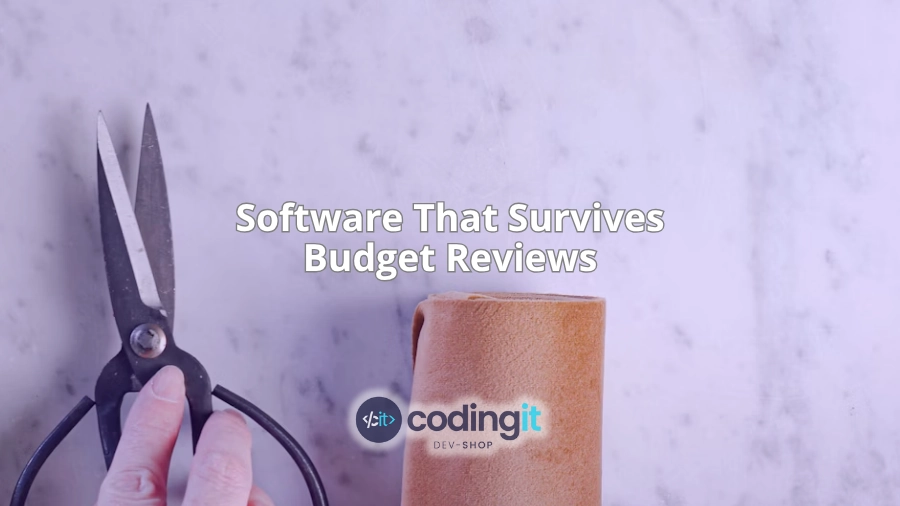When money gets tight, even good software gets cut. Some people might not want to see it, but it’s a reality.
It’s not a question of quality. It’s not about how hard your team worked, how elegant the architecture is, or how much it’s “used.” When budgets shrink, software goes under the microscope, and it’s a short, cold review. Does it save money? Does it replace something more expensive? Is it critical to a core process? If the answer isn’t obvious, it’s a liability.
This is where most internal tools, side platforms, and long-term “strategic bets” lose ground. They were built with good intentions. Some are even running smoothly. But when someone from finance sees a line item they don’t understand (and no one steps in to defend it), it gets grouped in with “things we can pause.”
I’m going to be brutally honest, decision-makers doing the cutting aren’t necessarily wrong. When you’re asked to trim spend by 20%, you don’t start by digging into ClickUp tasks. You look at what’s visible, what overlaps, and what has a clear owner. If your tool doesn’t show up in that layer, it gets swept up in the process.
This isn’t meant to sound cynical. It’s meant to be practical. Because once you accept that software is always one review away from being reconsidered, you start building differently. Not out of fear, but out of clarity.
Blog Summary:
We’ve seen smart tools cut, strong platforms questioned, and well-intentioned bets paused. Here’s what we’re going to unpack:
- Why usefulness isn’t the same as survivability.
- What kinds of tools quietly become liabilities.
- How software gets anchored to the parts of the business no one wants to break.
- What signals decision-makers look for when reviewing internal systems.
- The shift in thinking that helps product teams build with staying power.

Table of Contents:
Useful Isn’t a Strategy
Plenty of teams build genuinely useful tools. They automate manual work, reduce repetitive tasks, make internal handoffs smoother, or bring clarity to a messy process. That’s great. But “useful” on its own doesn’t win a budget conversation.
When cuts happen, the questions usually look at whether this particular software saves time in a measurable way, whether it replaces a cost, and whether anyone outside of the development team would notice if it disappeared. If the answers to those questions aren’t already documented, visible, or obvious to non-technical stakeholders, they’ll assume the value isn’t real.
That’s how tools get cut even when teams rely on them. “We use it every day” sounds like an endorsement, but to finance or leadership, it can also sound like internal convenience, something that makes life easier, not something that protects margin or drives revenue.
Common Traits of Cuttable Software
Not all software is at risk during budget reviews. But some types get flagged faster than others. Over time, certain patterns show up again and again. Again, these aren’t always bad tools. Many were built to solve real internal needs. But the ones that get cut tend to have one or more of the following traits:
- Redundant features: Solving problems that already have other solutions in the stack.
- Limited reach: only used by one team, with no visible dependencies from others.
- Unclear ROI: no baseline metrics, no business case, no before-and-after impact.
- No internal champion: no one in the room pushing back when it’s under review.
- Poor visibility: finance and leadership don’t understand what it does or why it exists.
Individually, these aren’t always dealbreakers. But when they stack up, they create a narrative that makes the software look like a nice-to-have, not a need-to-keep.
Anchoring to a Process
Software is easier to defend when it’s tied to a business process. A tool used by marketing to track campaign performance might be helpful, but if marketing is the only team touching it, it becomes an easy target. Compare that to a system that connects sales to billing. Or legal to procurement. The second one might not look exciting, but it’s harder to remove without breaking something meaningful.
This is what we mean by anchoring to a process. A process moves horizontally across functions. Tools that live inside those handoffs are harder to cut because removing them creates friction across multiple departments.
This applies just as much to internal platforms. Developer tooling that helps engineers move faster is often seen as internal overhead. But if that same platform is positioned as accelerating go-to-market speed, it suddenly ties into revenue timelines. That reframing matters when budget decisions are made.
Build Tools That Speak for Themselves
The biggest risk in a budget review for a software at risk is not being in the room when the questions get asked. If your tool needs a product manager to explain what it does, or a technical lead to defend why it matters, it’s already exposed. Tools that survive are the ones whose impact is obvious without one.
This is where visibility comes in. Not visual dashboards or adoption charts. Can decision-makers see where the tool fits in the business? Can they connect it to something they already care about? Cost, speed, risk, revenue?
Too many internal tools quietly automate something important but make no effort to surface that value. They work well, but they don’t show up. Over time, that invisibility becomes a weakness.
You can’t control who’s in the room during the next cost review. What you can control is whether the tool’s impact is obvious to people outside your team. That means instrumenting for visibility early. It means tying the tool to real metrics people already track. It means having users outside of product and engineering who would notice if it vanished.

Simplify the Story
A tool that can’t be explained in one sentence is easy to ignore. If leadership has to read a brief, book time with someone technical, or connect multiple dots just to understand what a system does, they’ll deprioritize it. Or worse, assume it’s replaceable.
We are not saying you should dumb down the explanation of what your software does. It means stripping the narrative to the essentials: who uses it, what outcome it enables, and what happens if it’s gone. That’s the version that survives procurement reviews, board slides, and offhand conversations where priorities are reshuffled without warning.
Too often, internal tools drift into complexity because they evolved fast or because they were never expected to justify themselves. And complexity in the narrative doesn’t signal sophistication. It signals opacity. You don’t need a better pitch. You need a clearer one. Because, in a budget discussion, opacity is risk.
Build Fewer Features
Yes, fewer. In a healthy roadmap, not every idea makes it to production. But in budget-constrained environments, even shipped features need to justify their presence.
Feature count is often a sign of overreach, not necessarily a sign of maturity. The more surface area your product has, the more reasons stakeholders have to question what’s essential and what isn’t. Every additional feature becomes another potential target.
Don’t cut scope for the sake of it. Focus on defensible features. They reduce a real cost, speed up a known process, or remove a measurable risk. If a feature can’t tie back to one of those, it becomes hard to keep in play when priorities shift.
Over time, a leaner product with a stronger defense will outperform a sprawling one with vague justifications. Especially when decisions are made by people who don’t know your roadmap, just your price tag.
Let Your Users Do the Talking
When software gets defended, it’s rarely by the people who built it. It’s by the people who would feel the pain if it disappeared. That’s why internal advocacy matters. I mean, as a signal that the tool has real traction beyond the team that owns it.
If people in finance, operations, sales, or legal speak up for something during a review, it immediately changes the conversation. It’s no longer a tool that engineering likes. It’s a tool the business relies on.
The best time to build that kind of support is before it’s needed. That means paying attention to who your users are, what value they’re seeing, and what they’d lose without it. When you hear strong language from users, capture it. Turn it into one-line defenses that can travel.
Think Like Finance, Ship Like Tech
When you think of value, you probably focus on usability, velocity, or engagement. But in a budget review, those aren’t the metrics that matter. There, value means operating cost, margin protection, and headcount efficiency.
Don’t worry, you don’t need to rebuild your roadmap around cost savings. You only need to add a second lens. For every feature or internal tool, ask: what line item does this affect? What does it replace? Who benefits, and how would they explain that value to someone outside the room?
It’s clear that the reason software gets cut has nothing to do with the code. It’s also about where it fits in the business, what it replaces, and how clearly that value shows up when it matters.
That’s why we don’t just focus on writing great software. Although we care deeply about that, too. We help teams build tools that solve the right problems, integrate into the right workflows, and come pre-loaded with the arguments they’ll need later. The ones that make sense in the roadmap and the budget meeting.
If that’s what you’re trying to build, we can help.
